The BAPM framework for pre-hospital management of the baby born at extreme preterm gestation
The unplanned birth of a baby in the pre-hospital environment, regardless of gestation, is always a concern for pre-hospital clinicians. When that baby is born before the point of viability, this is not only a distressing time for the parents but also for the clinicians who are tasked in dealing with the highly emotional situation.
Aimee Yarrington
Midwife and Paramedic, College of Paramedics
aimee.yarrington@collegeofparamedics.co.uk
Amanda Mansfield MBE
Joint Royal Colleges Ambulance Liaison Committee (JRCALC) Representative for Maternity and Newborn Care, Consultant Midwife, London Ambulance Service NHS Trust
Dawn Kerslake
Consultant Midwife, South East Coast Ambulance Service NHS Trust
Background to the framework
The British Association of Perinatal Medicine (BAPM) framework for practice, Pre-hospital Management of the Baby Born at Extreme Preterm Gestation, has been developed to assist clinicians through a pathway of management to provide the ethical and respectful care of a baby born before they reach the point of survival. The combined stresses of the birth being extremely premature, pre-hospital and with attending clinicians who have little specialist equipment and training, give rise to a great challenge.
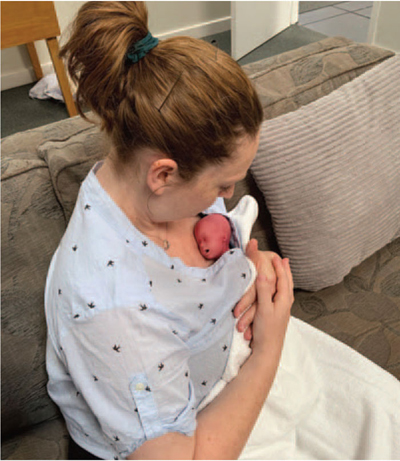
FIGURE 1 Skin-to-skin contact (in this case, using a preterm mannikin).
This framework for practice has been developed by a working group co-ordinated by BAPM and comprising experienced paramedic, mid-wifery and neonatal practitioners with expertise in pre-hospital care, emergency maternity care and resuscitation of the newborn. This consensus document has arisen from the initial work carried out by MBRRACE-UK national clinical guidance on determining signs of life following spontaneous birth before 24 weeks. It was determined within this group that no standardised information was available to pre-hospital clinicians and that situations often arose where professionals had a disagreement over the level of care that had been given. Therefore, this multidisciplinary framework aims to bridge this gap providing guidance for both pre-hospital and in-hospital staff to guide this most challenging time.
Practical interventions and advised approaches
This guidance introduces concepts not previously used for pre-hospital clinicians attending an unplanned birth at extreme gestation. The advocation of comfort-focused care may seem difficult to those used to providing active care and only withholding care in situations where there is legal paperwork in place (such as a DNAR – do not attempt resuscitation order).
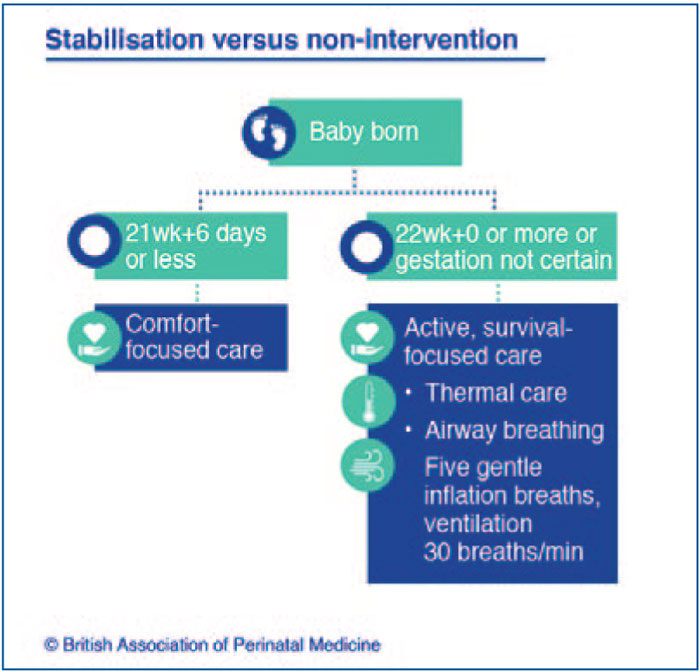
FIGURE 2 Survival-focused versus comfort-focused care.
Clinicians need to support parents to provide comfort care and attempt to ease their emotional distress. Comfort-focused care includes a discussion with the parents in which they are informed that the prognosis for the baby born at less than 22 completed weeks is poor. Use of effective sensitive communication can be helpful, with words such as: “Babies born before 22 weeks of gestation are small and their lungs and other organs are not developed enough for them to live after they are born.”
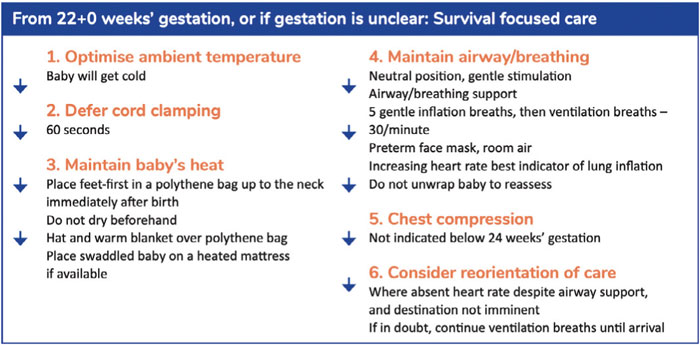
FIGURE 3 Survival-focused care: key points.
Clinicians are advised to:
- Encourage the parents to provide comfort for their baby if they feel able to; where they do not feel able, ensure a crew member provides the care.
- Reassure that occasional gasping or reflex movements of limbs do not indicate distress.
- Help parents to give close comfort and cuddling to keep the baby warm and secure – skin-to-skin contact where possible (FIGURE 1). Plastic bag wrapping is not appropriate
- Facilitate memory making for parents prior to and during conveyance. This can be by the provision of dignity and respect for the baby, using the baby’s name if given one.
These memories from this short time the parents have with their baby will be all they have to remember them so it is essential to assist where possible.
Survival-focused versus comfort-focused care
Where the gestation is known to be >22 weeks, or the gestation is unknown and cannot be confirmed, then survival-focused care should be initiated (FIGURE 2). Pre-hospital clinicians do not normally have access to maternity electronic notes, therefore, if the patient is not able to confidently tell the clinician their gestation, it will be treated as unknown and the survival-focused pathway should be initiated (FIGURE 3).
Key principles of the framework
Four principles underpin the recommended approach for para-medics and ambulance clinicians attending an out-of-hospital birth:
- Correct assessment: be aware of and prepared for potential complications during labour and birth that might compromise outcome for mother or baby. Determine the gestation of the baby, specifically if greater or less than 22 completed weeks. If the mother is unclear, access to maternity records, if available, may be helpful.
- Correct management:provide effective and timely delivery of appropriate interventions in the mother and baby’s best interests. For the majority, this will include attempted stabilisation of the baby, but for some babies, comfort-focused care will be appropriate.
- Correct destination: access the most appropriate neonatal and/or maternal expertise at the most appropriate location.
- Good communication: extremely preterm birth will be a frightening time for both the mother and her partner as well as the attending professionals. There is a high risk that the baby will not survive, and the language used at this highly emotional time will carry lasting memories for the parents.
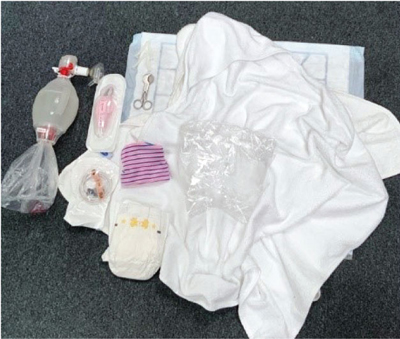
FIGURE 4 Recommended newborn equipment: size 1 iGel, 500mL bag valve mask, size 0 mask, self-heating mattress, pulse oximeter sensor, plastic bag.
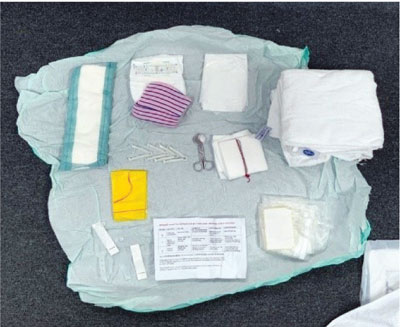
FIGURE 5 Recommended maternity pack: towels, hat and nappy, cord clamps, umbilical scissors, placenta bag, yellow waste bag, X-ray detectable gauze swabs, maternity pad, identity bracelets, Apgar or emergency card aide memoire.
Role of the neonatal team
This framework has been provided to ensure that there is a joint process for the seamless treatment of these challenging cases – having an appreciation of the challenges for the pre-hospital clinician is essential to assist in optimum care for the patient. All ambulance services utilise guidelines from the Joint Royal College Ambulance Liaison Committee (JRCALC). This framework guidance forms part of the ambulance service national guidelines. Equipment provided by each ambulance trust will vary but there is a set mandatory requirement and recommended equipment that should be carried (FIGURES 4 and 5).
For many pre-hospital clinicians, the frequency of these cases will be extremely rare, leading to apprehension and possible uncertainty. It is worth remembering that many may have never seen a baby born before and are even less likely to have seen a baby at the extreme of gestation. Kindness and understanding when debriefing after an event is essential and should always be sought at the earliest possibility, regardless of the outcome.
Tips for implementation
This framework is completely new guidance for pre-hospital clinicians. There will be a learning process as this is introduced as well as the implementation of new procedures and equipment.
Destination for the patient will depend upon local policy, however, it is recommended that conveyance to a maternity unit is preferable over emergency departments. Knowing hospital policy will help the crew to attend the correct destination as well as reduce stress for all clinicians involved.
Pre-hospital clinicians will not be familiar with comfort care so constructive feedback may help to assist with future cases. Limited equipment and resources mean that there may be regional variations and not all clinicians will have access to all equipment or had training in its use.
To read the framework, visit www.bapm.org/resources/pre-hospital-management-of-the-baby-born-at-extreme-preterm-gestation
Or read this article in our
Tablet/iPad edition


